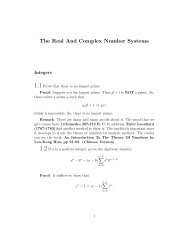Fiscal and monetary policy lags ⢠Automatic stabilizers ...
Fiscal and monetary policy lags ⢠Automatic stabilizers ...
Fiscal and monetary policy lags ⢠Automatic stabilizers ...
You also want an ePaper? Increase the reach of your titles
YUMPU automatically turns print PDFs into web optimized ePapers that Google loves.
assumption of a higher inflation rate in their wage dem<strong>and</strong>s. But if the Fed consistently tries to keepinflation under control (even though it may cause some unemployment in the short run), people will lowertheir inflationary expectations. The Fed will keep its reputation as an inflation fighter, <strong>and</strong> the economywill adjust back to full employment fairly rapidly.15. "Policy rules are always preferable to discretionary <strong>policy</strong>." Briefly comment on this statement.Policy rules predetermine the actions of <strong>policy</strong> makers <strong>and</strong> thus eliminate the uncertainty of governmentactions. This may reduce some of the instability that arises from mistaken expectations. Unfortunately,however, rules do not allow enough flexibility to respond to unforeseen events <strong>and</strong> cannot accommodatethe range of policies required to reduce large <strong>and</strong> prolonged disturbances.16. Explain why it is important for the Fed to have credibility in its effort to maintain pricestability.Credibility is very important for the Fed, since consistent government actions lead to more accurateprivate sector expectations. For example, if the Fed were to follow a <strong>monetary</strong> growth rule, then peoplecould more easily anticipate the effects of a disturbance <strong>and</strong> could adjust to it. If the Fed consistently triesto keep inflation under control, even though it may cause some unemployment in the short run, peoplekeep their inflationary expectations low <strong>and</strong> adjust their wage dem<strong>and</strong>s downwards. But if the Fed has areputation of changing its <strong>monetary</strong> <strong>policy</strong> often <strong>and</strong> unpredictably, its policies may not have the desiredeffects, since people may not react in the desired way. As a result, active <strong>monetary</strong> <strong>policy</strong> may actually bedestabilizing.17. "A <strong>monetary</strong> <strong>policy</strong> rule is preferable to discretionary stabilization <strong>policy</strong>." Comment on thisstatement. In your answer discuss the arguments for <strong>and</strong> against fine tuning the economy.Policy rules make the actions of <strong>policy</strong> makers predictable <strong>and</strong> thus eliminate the uncertainty that comesfrom unanticipated government actions. They also may reduce instability arising from mistakenexpectations. However, rules do not allow flexibility in responding to unforeseen large <strong>and</strong> prolongeddisturbances. Only a very strong proponent of monetarism or the rational expectations approach wouldpropose a strict <strong>monetary</strong> growth rule.Fine tuning the economy involves the use of <strong>policy</strong> tools for all (even small) disturbances. But sincethere are always <strong>policy</strong> <strong>lags</strong> <strong>and</strong> uncertainty about the length of disturbances, fine-tuning may actually bedestabilizing. Therefore small <strong>policy</strong> responses should be undertaken initially <strong>and</strong> revised later, as moreinformation about the true nature of the disturbance becomes available.18. "The economy always adjusts back to the full-employment level of output, so <strong>policy</strong> makersshould not be concerned with undertaking active stabilization <strong>policy</strong>. Instead they shouldestablish more credibility by following a well-defined <strong>policy</strong> rule." Comment on this statement.Since wages are flexible in the long run, the economy will always eventually adjust back to fullemployment. According to the Phillips-curve analysis, the economy will be at full employment as long asexpected inflation is equal to actual inflation. Therefore, <strong>policy</strong> makers can create more rational119
















